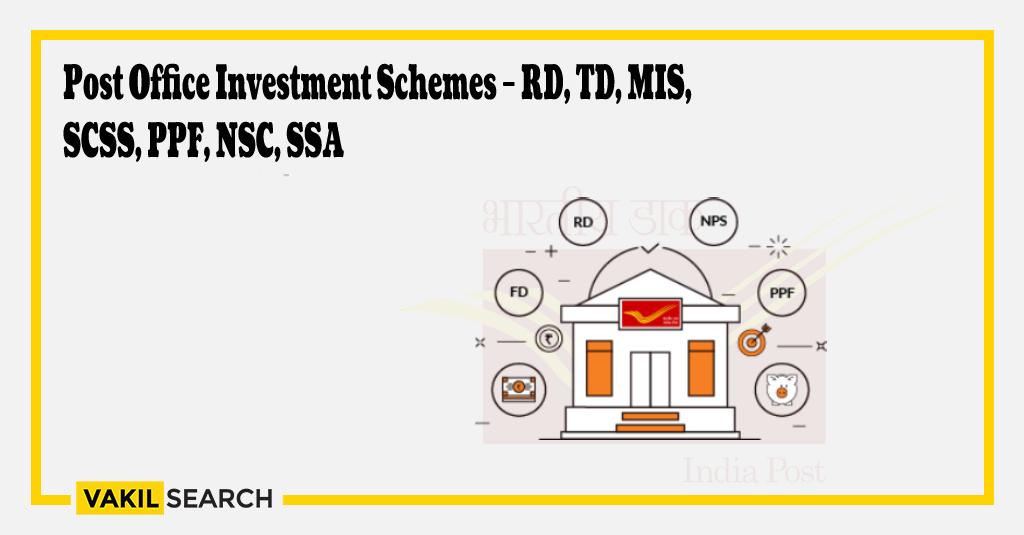The Post Office investment schemes offer a variety of reliable products as well as risk-free returns on investments. Read this blog to know more about the scheme.
Numerous trustworthy items are included in the Post Office Investment Schemes, or the Dakghar Bachat Yojana, which also provide risk-free rewards on investments.
Post Office Investment Schemes for Savings

-
Post Office Savings Account
- A post office savings scheme account must have a minimum deposit of ₹500 to be opened.
- Domestic customers have the option of opening an account under sole or joint ownership.
- On deposits made to the post office account, there is a 4% annual Post Office interest rate that is applicable.
- On request, you can use the account with a chequebook, an ATM card, e-banking, mobile banking, and other services. After each fiscal year, interest is credited.
- Under Section 80TTA of the Income Tax Act, individuals are eligible for a deduction of up to ₹10,000 from their total income.
-
5-Year Post Office RD Account (Recurring Deposit)
- The duration of this RD account is fixed for five years, as the name would imply.
- Starting at ₹100, you can agree to a fixed monthly deposit payment and receive interest at a rate of 5.8% p.a.
- Quarterly compounding is used for interest.
- Following the completion of 12 installments without a default, you are eligible for a loan of up to 50% against the deposit that is currently in the account.
-
Post Office Time Deposit Account (TD)
- You can choose from four different post office time deposit account tenures: one year, two years, three years, and five years.
- The account’s minimum deposit requirement is ₹1,000.
- The investment in the five-year maturity account will be eligible for a Section 80C deduction.
- Additionally, scheduled or cooperative banks may accept a pledge of the Post Office TD account as security.
- A deposit cannot be withdrawn until six months have passed since the date of the deposit.
- Interest is computed every quarter, but it is paid on an annual basis. The Post Office interest rates for Q4 FY 2022-23, from 1 January 2023 to 31 March 2023, are listed below.
| Period | Rate |
| 1 year account | 6.6% |
| 2 year account | 6.8% |
| 3 year account | 6.9% |
| 5 year account | 7% |
-
Post Office Monthly Income Scheme Account (MIS)
- Up to 4.5 lakh rupees can be deposited in a single account, and up to 9 lakh rupees can be deposited in a joint account.
- Through this account, you can receive a rate of interest of 6.6% per year and benefit from the investment scheme’s set monthly income.
- You are not permitted to close your account before the year has passed. Over one year early closure may result in fines.
- For instance, if you deposit up to ₹4.5 lakh in a Post office MIS account for a period of 5 years, you will earn ₹2,475 in interest each month until the term is through. Somewhere at the end of the 5 term, you will receive the ₹4.5 lakh deposit that you made.
- While interest from post office MIS is paid out every month while the scheme is in effect, interest from post office TD/RD is paid out at the conclusion of the term.
-
Senior Citizen Savings Scheme (SCSS)
- This is a retirement programme that is sponsored by the government and allows you to make a single, lump-sum payment.
- The deposit can be from one rupee up to fifteen lakh rupees.
- Only a spouse may open the account jointly or individually.
- The account can be opened by anyone who is older than 60.
- Retirement benefits must be invested within one month of the date of receipt for retired civilian employees who are 55 to 60 years old and retired military personnel who are 50 to 60 years old to start an account.
- Under Section 80C of the Income Tax Act, the investment made as part of this plan is deductible.
-
Public Provident Fund Account (PPF)
- As a retirement and investing vehicle, PPF is favoured by many salaried people because it provides income tax deductions of up to ₹1.5 lakh every fiscal year under Section 80C.
- The account requires a minimum deposit of ₹500 and a maximum deposit of ₹1.5 lakh.
- After the account is opened, the account will remain open for 15 years. To keep the account operational, you only need to pay ₹500 a year.
- The programme offers a 7.1% p.a. compounded annual Post Office interest rate. Additionally, this account’s interest is tax-free.
- Under Section 80C of the Income Tax Act, the PPF investment amount may be deducted.
- The investor has the option of extending the account for another five years.
-
National Savings Certificates (NSC)
- NSC has a five-year term, and there is a ₹1,000 minimum deposit requirement.
- For this account, there is no set maximum deposit amount.
- Only at maturity is the 6.8% yearly compounded interest rate paid out.
- Under the plan, a person may create as many accounts as desired.
- To the home finance firm, banks, government organisations, and others, the certificate may be transferred or pledged as security.
- For instance, an investment of ₹1,000,000 will increase to ₹1,38,949.29 after five years.
- This account’s deposit amount is eligible for a Section 80C deduction.
- NSC is a security that can be committed to co-operative or scheduled banks.
- National Savings Certificate (VIIIth Issue) is currently available.
-
Kisan Vikas Patra (KVP)
- The allure of this programme is that it allows you to double your investment during the course of the account.
- For this account, a ₹1,000 minimum deposit is required. The applicable interest rate is 6.9% p.a. according to the rates for the fourth quarter of the fiscal year 2020–21.
- It has been open for 124 months (10 years and four months). During this time, the investment doubles. In 124 months, a ₹1 lakh investment in KVP will increase to ₹2 lakh.
- Please be aware that the account’s tenure changes when the interest rate changes.
- KVP is a security that can be pledged to scheduled or cooperative banks.
-
Sukanya Samriddhi Accounts (SSA)
- This is a government initiative aimed at ensuring the financial security of young girls.
- The benefits of this account are only available to girl children under the age of ten.
- Until the girl child becomes 18, the account must be opened and managed by parents or legal guardians.
- The minimum and maximum deposits each financial year are 250 and 1.5 lakhs respectively.
- There is an interest rate of 7.6% each year. Every year, the interest is calculated and compounded.
- Taxes are not due on interest income.
- The account can be managed by the guardian until the girl kid turns 18 years old.
- A maximum of 15 years from the account opening date are allowed for deposits.
- Section 80C of the Income Tax Act allows deductions for contributions made to SSA accounts.
Advantages of Post Office Investment Schemes in India
-
Easy to Invest
The saving plans are simple to join and are ideal for both urban and rural investors. These programmes are open to everyone who wishes to manage risk in their portfolio for a guaranteed respectable return. These investments are a popular choice for saving and investing money because of their accessibility and simplicity.
-
Documentation and Procedures
Since the government backs them, these savings schemes are easy to choose from and secure to hold onto thanks to minimal paperwork and rigorous post office procedures.
-
Fulfillment of Investments Goals
With a PPF account’s maximum investment tenure of 15 years, Post Office Schemes investments are long-term in nature. As a result, these investment choices are fantastic for pension and retirement planning.
-
Tax Exemption
For the deposit amount, the majority of these programs qualify for tax breaks under Section 80C. A few programs, such as the PPF, the Sukanya Samriddhi Yojana, etc., also exempt the amount of interest received from taxes.
-
Interest Rates
These programs offer risk-free interest rate in the 4% to 9% range. Due to the Government of India’s involvement in these investing alternatives, there is very little risk.
-
Different Buckets of Products
There are many different items based on various types of people. Public Provident Fund (PPF), Kisan Vikas Patra, and Sukanya Samriddhi Yojanas are well-known programmes. These small savings programmes have been made available by the government through post offices to give the general population a safe outlet for investing by offering lucrative returns and safeguarding their investments. These plans are simple to control. If the aforementioned characteristics and advantages align with your financial objectives, consider investing in a post office scheme 2023 plan to protect your financial future with little risk.
Post Office Savings Plans are appropriate for people who prefer low levels of risk. These schemes are perfect for risk-averse investors who nevertheless want to maximise their savings because the rewards are not subject to market swings.
Through the mobile app, you can sign up for a term deposit or recurring deposit account online.
Conclusion
We hope this blog will come handy whenever you will need help regarding Post Office Investment in India. Also, in case of any queries, you can contact Vakilsearch. Our legal team of experts will keep no stone unturned to help you in this process.
Helpful Links










